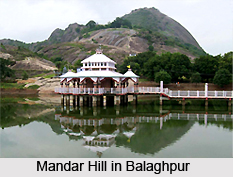 Bhagalpur is renowned worldwide for its silk production. The city has been producing silk for generations and is known as the "Silk City". Bhagalpur finds mention in the Ramayana and Mahabharata. In the epics, the city is described as kingdom of Anga. Angika, which is the main language of Bhagalpur is one of the oldest languages of the world. It is spoken by more than 30 million of Indians and around 50 million people worldwide. The city was also a great centre of learning. This is evident from the ruins of the ancient Vikramshila University, which is located 44 km east of Bhagalpur.
Bhagalpur is renowned worldwide for its silk production. The city has been producing silk for generations and is known as the "Silk City". Bhagalpur finds mention in the Ramayana and Mahabharata. In the epics, the city is described as kingdom of Anga. Angika, which is the main language of Bhagalpur is one of the oldest languages of the world. It is spoken by more than 30 million of Indians and around 50 million people worldwide. The city was also a great centre of learning. This is evident from the ruins of the ancient Vikramshila University, which is located 44 km east of Bhagalpur.
Location of Bhagalpur
Bhagalpur is located in Bihar, Eastern India. The city is situated on the banks of river Ganges. The plain on which the city is located is very fertile and is conducive for the growth of plants and crops. Bhagalpur covers an area of 110 square kilometres. It is positioned 220 km east of Patna and 60 km east of Munger.
History of Bhagalpur
In the Ramayana, Mahabharata and Panchtantra, Bhagalpur is referred to as Bhagaddat-Puram. The worship of the snake queen which was celebrated hundreds of years back is still celebrated here with great pomp.
Bhagalpur was part of the ancient Sanskrit kingdom of Anga. In the later times, it was included in the powerful Hindu kingdom of Magadha or Behar, and in the 7th century, it became an independent state. And afterwards became the Mahommedan kingdom of Gaur, and was subsequently subjugated by Akbar, who declared it to be a part of the Delhi Empire. In 1765, it was passed to the East India Company by Emperor Shah Alam.
Demography of Bhagalpur
On the basis of 2011 India census, the city registered a population of 398,138. Bhagalpur is the second important city of Bihar after Patna. It serves as the administrative headquarters of the Bhagalpur district and Bhagalpur Division.
Education in Balaghpur
Bhagalpur is one of the leading education centres of Bihar. Students of Balaghpur often make a record in History being toppers in Board Examination and producing a large number of IAS/IPS officers in the country. Bhagalpur also has some of the best schools in the country that provide quality education to the students. There is a Silk Institute and Agricultural college here, as well as a University, and Engineering, Medical and Homeopath colleges.
Attractions of Balaghpur
The city of Balaghpur houses a large number of tourist attractions like Vikramshila University, Mandar Hill, Colganj Temple, Sultanganj etc. Vikramshila University is located in the town of Vikramshila which is 40 km from the city of Bhagalpur. Mandar Hill is nestled 30 km from Bhagalpur and is famous for its mythological background. Colganj temple is famous for its rock cut carvings and Sultanganj serves as an important religious centre for the Hindus.
Connectivity of Balaghpur
The city is well connected via railway and road. Bhagalpur Junction railway station which is the 3rd busiest line in Bihar is connected to most of the major cities in India. The road network of Balaghpur is also impressive. The city has approximately 200 km road area and the transport system is well maintained.



















